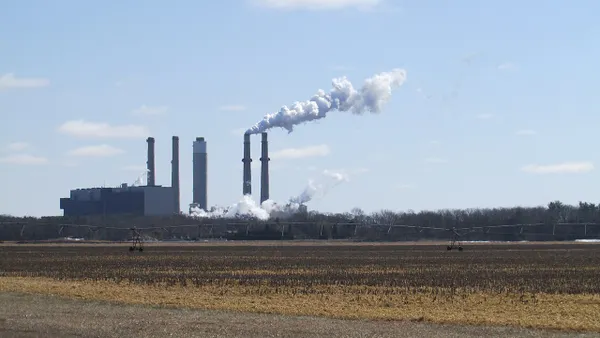Dive Brief:
- The Department of Energy wants the private sector to help it develop small modular coal-fired power plants, a senior DOE official told reporters at a Houston energy conference this week.
- The comments reinforce a goal in DOE's budget justification document that would see the agency develop at least two designs of small or modular coal plants — without carbon capture — by 2022. The budget requests $175 million to meet that goal and develop new, higher efficiency coal generators.
- The budget proposal reflects a shift in focus at DOE from carbon capture and storage (CCS) to the development of higher efficiency coal plants without carbon control technologies. Despite the shift, U.S. utilities overwhelmingly say they are not likely to develop new coal generators.
Dive Insight:
Typically in the power sector, the words "small" and "modular" are applied to nuclear reactor technologies.
The subject of a separate DOE funding initiative, the nuclear industry and senior agency officials hope these small modular reactors (SMRs) will revolutionize the sector by allowing a flexible, zero-carbon generation source that operates around the clock.
But DOE officials are also pushing the development of small modular coal plants, a senior official told media this week at the CERAWeek conference in Houston. The agency will set up competitive funding opportunities with cost share requirements, Steve Winberg, assistant secretary for fossil energy, told Axios, and DOE plans to issue a request for proposals on new plant designs.
Winberg told the Houston Chronicle that while DOE's budget proposal would cut carbon capture research by 80%, CCS work would not halt at the agency. Small plants will be better suited for carbon capture upgrades, he said.
The comments reflect new priorities in the Department of Energy's budget proposal, which requests a 50% increase in funding for high efficiency coal plants and small, modular designs.
By the end of fiscal year 2022, DOE wants this funding to result in at least three technologies that "improve the average heat rate (i.e., efficiency) of a typical plant in the existing fleet by 5% from the 2017 baseline of 30%."
Additionally, DOE would target the development of "at least two designs of advanced high efficiency (greater than or equal to 42% on a higher heating value basis), low emission (HELE) coal fired, small-scale and/or modular units that have flexible operating capacity to meet baseload and load following requirements needed for the evolving grid."
The new emphasis on small coal plants without carbon capture reflects a broader shift in what the DOE and the Trump administration consider "clean coal." While the term has traditionally referred to plants with CCS installed, many senior administration officials use it for plants without the technology.
During a visit to a high efficiency coal plant this summer, Energy Secretary Rick Perry reportedly indicated that when the administration uses the term "clean coal," it also refers to the more efficient combustion technologies. EPA Administrator Scott Pruitt was also scheduled to travel to a Japanese ultra-supercritical plant in January before a government shutdown derailed his plans.
Enhancing coal plant efficiency is also likely to form the foundation of Pruitt's replacement for the Clean Power Plan, an Obama-era pollution regulation. Instead of pushing coal plant owners to invest in lower-emitting fuel sources, the replacement rule is likely to only require modest efficiency upgrades at existing plants.
The new administration paradigm for "clean coal" aligns with calls from some influential coal industry figures to shift away from CCS. In a memo delivered to the White House last year coal magnate Bob Murray called CCS a "pseudonym for no coal" and urged an elimination of funding. A number of Trump administration actions on energy have aligned with the memo, including the DOE's proposal to lend cost recovery to coal and nuclear plants.
Regardless of the DOE's new focus, utilities in the U.S. say they are unlikely to add new coal generation of any size. Utility Dive's recent survey of nearly 700 electric utility professionals, conducted in Dec. 2017, revealed that the vast majority of utilities expect coal to decrease significantly as a part of their fuel mix, and virtually no one expects to add coal-fired capacity.













